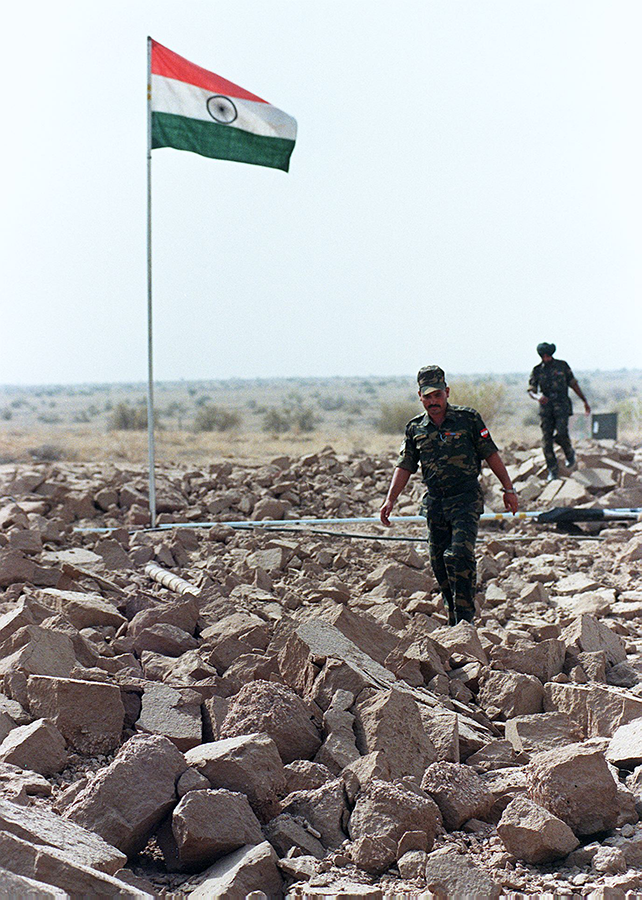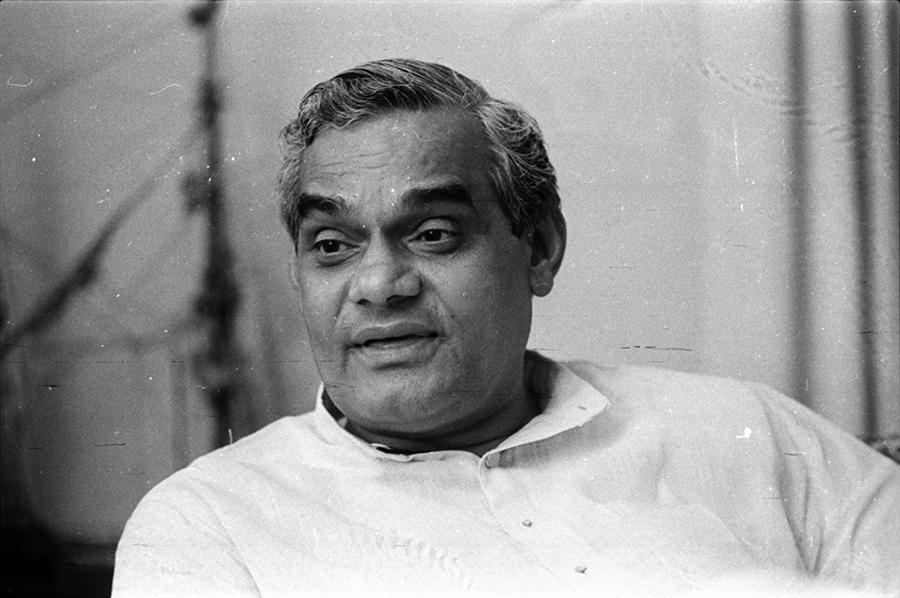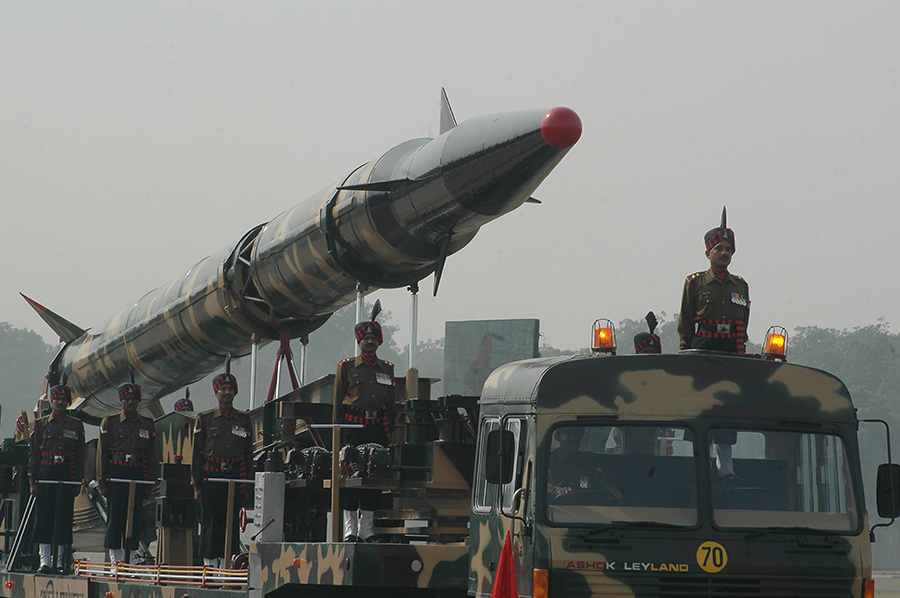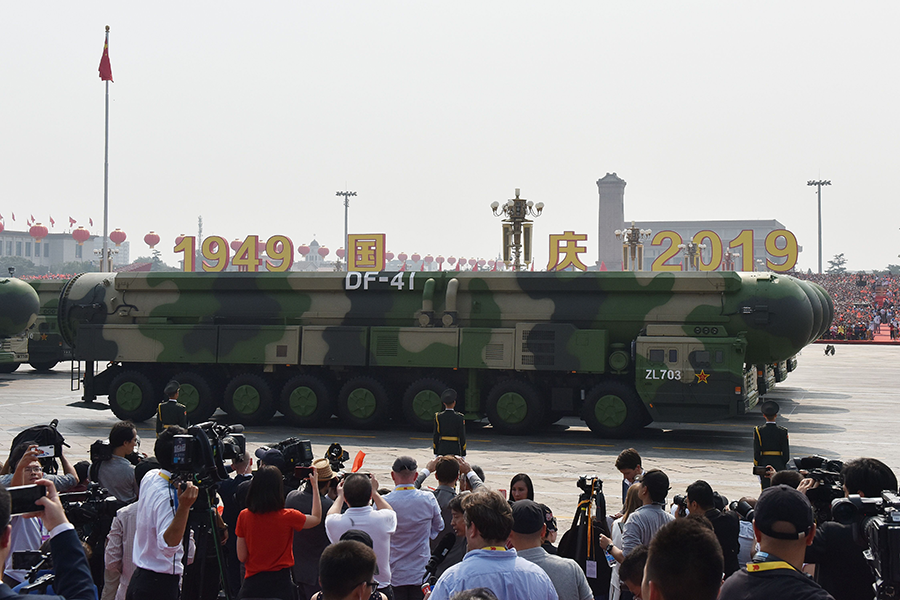"The Arms Control Association’s work is an important resource to legislators and policymakers when contemplating a new policy direction or decision."
Twenty-Five Years of Overt Nuclear India
October 2023
By Christopher Clary
What are the requirements of nuclear deterrence? How many nuclear weapons, and of what type, are needed to ensure national survival? These answers are not immediately apparent from careful deduction or induction. Different states have made different assessments, the same states have changed their assessments over time, and within states, there have often been harsh disagreements on the topic.
 When India opted to test nuclear weapons in 1998, the government offered what it argued would be a clear, definitive answer about what it sought to achieve with the tests: “credible minimum deterrence.” Nothing more was needed, but nothing less would do. Yet as such officials acknowledged even in the initial years, there was always a tension between the two adjectives that framed their nuclear thinking. That is, the need for credibility would inevitably pull up the requirements for deterrence beyond a minimum number of weapons. How much was the tricky part.
When India opted to test nuclear weapons in 1998, the government offered what it argued would be a clear, definitive answer about what it sought to achieve with the tests: “credible minimum deterrence.” Nothing more was needed, but nothing less would do. Yet as such officials acknowledged even in the initial years, there was always a tension between the two adjectives that framed their nuclear thinking. That is, the need for credibility would inevitably pull up the requirements for deterrence beyond a minimum number of weapons. How much was the tricky part.
Now, 25 years later, Indian decision-makers have yet to conclude that they have met the requisite minimum needed for deterrence as they continue to pursue credibility. This pursuit has resulted in a slow but steady quantitative and qualitative modernization of the Indian arsenal. India pursues such steps even as Pakistan continues its own nuclear modernization and as China embarks on a nuclear expansion that is unparalleled in that nation’s nuclear history. Whether India’s deliberate pace is adequate to India’s credible but minimum deterrence needs will be a dominant question facing the country’s nuclear stewards in the coming decade.
Nuclear Tests and Afterward
In 1998, Indian Prime Minister Atal Bihari Vajpayee explained to U.S. President Bill Clinton that he had authorized new nuclear tests because he viewed a “deteriorating security environment” in the region. India faced an overt nuclear weapons state on its border, China, that had materially helped another neighbor, Pakistan, to become a covert nuclear state, he argued. Further, he explained, both countries had committed aggression against India in the past.1
India previously tested a nuclear explosive device in 1974, but framed that test publicly as a “peaceful nuclear explosion” rather than a weapons test. Although the peaceful appellation was not especially convincing to outsiders, the design of the device was not ruggedized or weaponized for delivery until renewed work on the project began in earnest in the late 1980s.2 Despite progress in secret, the semicovert nature of the program limited India in the steps it could take to deploy a ready arsenal. Some Indians thought it called into question the credibility of the deterrent, and others perceived an intolerable status deficit between India and other nuclear-armed states in the international system, a kind of “nuclear apartheid.”3
In these circumstances, India decided to conduct a brief series of nuclear explosive device tests on May 11 and 13, 1998. This overt testing triggered a short but intense round of nuclear weapons sanctions. Those sanctions proved transitory. By the end of the George W. Bush administration, Washington had shifted from treating India as a nonproliferation rogue to wooing India as a valuable strategic partner.
At the time of the 1998 tests, India’s ability to confront nuclear challenges from its regional foes was limited. New Delhi could deliver nuclear warheads only by aircraft or the short-range Prithvi-1 liquid-fueled missile, which had uncertain reliability even against many Pakistani targets and could reach only a small subset of Chinese population centers, notably not Beijing. Today, most nongovernmental analysts assess that India retains its aircraft-delivered weapons while adding four variants of the solid-fueled Agni missile family to the arsenal, with perhaps three more Agni variants in development. All of India’s land-based missiles are road or rail mobile. These aircraft-delivered and land-based elements are supplemented now by a seaborne leg with a few ship-based, short-range Dhanush ballistic missiles, which are of uncertain utility, and periodic operational deployments of a nuclear-powered submarine capable of carrying the short-range Kalam-15 (K-15) submarine-launched ballistic missile.
Today, India can target the entirety of Pakistan with a variety of nuclear-capable systems, while Indian coverage of the Chinese eastern seaboard remains limited. As India deploys newer variants of the Agni missile family and the longer-range Kalam-4 (K-4) and Kalam-5 (K-5) submarine-launched missiles, India’s ability to hold all of China at risk should be credible even to skeptical observers by the end of the decade. Although some sources refer to Indian cruise missiles, such as the BrahMos and Nirbhay, as nuclear capable, such sources are not authoritative. India may have sufficient fissile material for additional warheads, but most nongovernmental analysts assess that the government has deployed perhaps 160 warheads. Such a number, if correct, would place India at or near parity with Pakistan but substantially below estimates of the growing Chinese arsenal.4
Counterforce Temptations
In part out of sincere conviction and in part out of a desire to defuse international condemnation for its 1998 nuclear tests, India in subsequent years has promulgated a series of policy statements to showcase that its new nuclear deterrent would be at the minimum level possible while still appearing credible to India’s adversaries. New Delhi declared that it would adhere to a doctrine of no first use of nuclear weapons, thus underscoring its view that “the principal role of nuclear weapons is to deter their use by an adversary.” Indian officials “discarded” the possibility of nuclear war-fighting and promised that India would “not engage in any arms race.”5
Yet even as the government reiterated its commitment over the years to a no-first-use policy, a portion of India’s strategic community continued to question the wisdom of restraining India’s options during contingencies in which national survival would be on the line. By 2003, the Indian cabinet committee on security released a document on “operationalizing” the nuclear doctrine that made it clear India’s no-first-use commitment did not apply in the face of a major attack with chemical or biological weapons. Such a no-first-use commitment is arguably a mere caveat rather than a major doctrinal evolution, although the history of powers falsely or erroneously accusing one another of chemical or biological weapons use makes the caveat somewhat more worrisome.
 Despite his government’s role in promulgating the no-first-use doctrine, Vajpayee himself was not always dogmatic in his public messaging on the issue. In 2000, in the face of what he viewed as unacceptable Pakistani nuclear threats, Vajpayee declared, “If [Pakistanis] think we would wait for them to drop a bomb and face destruction, they are mistaken.” Separately, multiple former Indian strategic force commanders have advocated for greater doctrinal ambiguity to permit rapid retaliatory or preemptive options in the event of likely adversary nuclear use. Some commanders even have argued that Indian leaders might have a moral obligation to consider preemptive counterforce nuclear strikes if they believed meaningful damage limitation was achievable.
Despite his government’s role in promulgating the no-first-use doctrine, Vajpayee himself was not always dogmatic in his public messaging on the issue. In 2000, in the face of what he viewed as unacceptable Pakistani nuclear threats, Vajpayee declared, “If [Pakistanis] think we would wait for them to drop a bomb and face destruction, they are mistaken.” Separately, multiple former Indian strategic force commanders have advocated for greater doctrinal ambiguity to permit rapid retaliatory or preemptive options in the event of likely adversary nuclear use. Some commanders even have argued that Indian leaders might have a moral obligation to consider preemptive counterforce nuclear strikes if they believed meaningful damage limitation was achievable.
At a minimum, there seemingly was widespread support within the military for the use of conventional weapons against nuclear or dual-use launch vehicles, and at least some civilians and military officers believed India should have the option to move beyond conventional counterforce to nuclear counterforce if need be. In 2016, India’s former defense minister stated that, “in a personal capacity,” he did not understand why India should “bind” itself publicly to a no-first-use commitment. That same year, a former Indian national security adviser wrote in his memoirs that a careful reading of Indian doctrine might permit the preemptive use of nuclear weapons as part of a broader argument that “India’s nuclear doctrine has far greater flexibility than it gets credit for.”6
When nongovernmental analysts began pointing out that such messages indicated that India might be shifting away from an ironclad no-first-use policy, such analyses did not prompt a full-throated refutation by Indian officials.7 Instead, Indian Defense Minister Rajnath Singh visited the Pokhran nuclear test site in August 2019, where he reiterated India’s prior commitment to a no-first-use doctrine but suggested that such a commitment might not be enduring. “India has strictly adhered to this doctrine. What happens in [the] future depends on the circumstances,” he said.8
 These ambiguities in signaling were accompanied by continued Indian capability developments that seemed at variance with the goal of a credible minimum deterrence. Although in the aftermath of the 1998 tests India initially had framed the doctrine almost exclusively in terms of the minimum requirements for credibility, the government subsequently articulated that its retaliatory strikes would be “massive and designed to inflict unacceptable damage.”
These ambiguities in signaling were accompanied by continued Indian capability developments that seemed at variance with the goal of a credible minimum deterrence. Although in the aftermath of the 1998 tests India initially had framed the doctrine almost exclusively in terms of the minimum requirements for credibility, the government subsequently articulated that its retaliatory strikes would be “massive and designed to inflict unacceptable damage.”
Massive retaliation is compatible with smaller arsenals, especially in contrast to flexible response or other nuclear war-fighting strategies, but India was silent on the sorts of targets that would face retaliatory strikes. Many informed observers argued that Indian doctrine was most consistent with a countervalue, city-targeting strategy. By refusing to retaliate until after India was attacked with nuclear weapons, government and military leaders would want to ensure that whatever force survived could still cause sufficient damage to deter even the most callous opponent. “With a no-first-use posture, if in the remote contingency that India is to respond to a nuclear attack, it would be most logical to use the weapons on cities instead of on purely military targets,” Indian analyst Manpreet Sethi assessed.9
Such a city-killing, massive retaliation strategy would reduce the technological burden faced by Indian scientists because an exquisite or large force was not required, merely a survivable one. This was consistent with prior Indian messaging that although the requirements of minimum credible deterrence were “dynamic,” they were not “open-ended.” As officials seemed to indicate in the initial years after the 1998 tests, India would have an arsenal to deter any plausible foe in the near future. This was not a never-ending journey but one with a reachable destination.
Twenty-five years later, New Delhi still seems far away from its deterrence goals. Some desired requirements seem imminently reasonable, such as the need to have at least a few dozen missiles capable of reaching targets as far as Beijing. Yet even today, most of the Indian nuclear arsenal is only able to reach western and central China. Other sought-after requirements are more debatable, such as the number of ballistic missile submarines India requires and whether submarine deterrence patrols need to be continuous or only occasional.
Still other decisions India has made seem incompatible with an arsenal designed for countervalue retaliatory attacks. Indian defense scientists have been eager to publicize that even their longer-range ballistic missiles have achieved a degree of accuracy that appears greater than necessary for countercity attacks. Their repeated announcements that tests across all missile types have achieved “pinpoint” accuracy with a “single-digit” and “close to zero” error rate suggests possible counterforce aspirations because such accuracy is not needed for the gruesome task of city killing. These advertised accuracy improvements have occurred alongside other changes in India’s posture, including apparent gains in the peacetime readiness of the arsenal. Such changes make it quicker and less detectable to prepare at least a subset of India’s nuclear weapons for use than it would have been in the early years of the program.
Taken together, these developments indicate that Indian officials are tempted by counterforce options, as demonstrated by their occasional but repeated public statements expressing skepticism about inalterable no-first-use commitments. As a consequence of this interest and as indicated by the capability developments, the Indian defense establishment has invested some energy and resources into making those options executable.
The pursuit of counterforce options might be incompatible with the spirit of the no-first-use doctrine, but it does not imply that India has or will soon change its declaratory doctrine. Such options might presage such a public change in policy, but Indian officials also might decide such mixed signals are useful, or in time they could reject counterforce options as infeasible. Hedging strategies are often difficult to distinguish from steadfast pursuit. This could be such a circumstance.
This interpretation of conscious bureaucratic intent is not the only conclusion that could be drawn from the available data. Other experts, such as former U.S. official Ashley Tellis, have argued that most Indian policymakers “are not well versed in the arcane terminology of nuclear deterrence theory” and thus any statements that are inconsistent with no-first-use adherence should be discarded. With regard to capabilities that are inconsistent with countervalue targeting, Tellis and others say that Indian scientists simply have exaggerated the capabilities that their systems have achieved and such claims should be discounted as promotional puffery and little more.10 Even if such braggart scientists view their primary audience as the Indian public, these recurrent capability claims reach external audiences as well. Because one primary goal of no-first-use doctrines is to reassure adversaries, public articulations of Indian doubts and caveats on the doctrine combined with these capability revelations serve at a minimum to undercut such reassurance.
Confronting a Chinese Sprint
In 2021 the United States charged that China was undertaking a significant, rapid expansion of its nuclear force. This intelligence assessment was buttressed by nongovernmental analysts with access to commercial satellite imagery who located sites in China that showed apparent large-scale construction of silos consistent with such an expansion. The U.S. Department of Defense projected that China “likely intends to have at least 1,000 warheads by 2030,” a substantial increase from prior assessments, which had placed the size of China’s nuclear warhead stockpile in the low 200s.11
 Since China acquired nuclear weapons in 1964, there has been a meaningful nuclear asymmetry between it and India. Prior to India’s 1974 nuclear explosive device test, that asymmetry was totally in China’s favor. After 1974, India was slow to weaponize its nuclear explosive design, and it struggled to produce a weapon that could strike major Chinese population centers. Even once Indian work on weaponization began in the late 1980s, Chinese targets could only be held at risk by Indian aircraft. Into the 1990s, when China had a remarkably limited ability to target the continental United States, India’s geographic proximity meant China had many delivery vehicles capable of reaching into India, including medium- and intermediate-range ballistic missiles and bomber aircraft. This asymmetry moderated a decade ago, when New Delhi finally deployed the Agni-2 and Agni-3 missiles. Only then did India have a credible means to reach many Chinese targets. It took several more years and the deployment of the Agni-4 missile for India to achieve the ability to credibly threaten major eastern coastal population centers in China, such as Beijing.
Since China acquired nuclear weapons in 1964, there has been a meaningful nuclear asymmetry between it and India. Prior to India’s 1974 nuclear explosive device test, that asymmetry was totally in China’s favor. After 1974, India was slow to weaponize its nuclear explosive design, and it struggled to produce a weapon that could strike major Chinese population centers. Even once Indian work on weaponization began in the late 1980s, Chinese targets could only be held at risk by Indian aircraft. Into the 1990s, when China had a remarkably limited ability to target the continental United States, India’s geographic proximity meant China had many delivery vehicles capable of reaching into India, including medium- and intermediate-range ballistic missiles and bomber aircraft. This asymmetry moderated a decade ago, when New Delhi finally deployed the Agni-2 and Agni-3 missiles. Only then did India have a credible means to reach many Chinese targets. It took several more years and the deployment of the Agni-4 missile for India to achieve the ability to credibly threaten major eastern coastal population centers in China, such as Beijing.
As India was securing a measure of nuclear parity, the new modernization effort by China has opened the prospect that China will sprint away from India quantitatively and perhaps qualitatively. Although Indian commentators have long maintained that New Delhi will not have to match Beijing’s expansion “warhead for warhead” or “system for system,” they have conceded, as one said, that “[o]bviously there is a need to adjust the numbers” of Indian weapons in the context of an accelerated Chinese buildup.12 The extent of the requisite numerical adjustment in Indian systems, however, has not been clarified.
One qualitative asymmetry that might exacerbate any growing numerical disparity is the perceived reliability and expected yield of India’s nuclear warheads. India’s 1998 tests were designed to test a weaponized fission design, but they also sought to validate a thermonuclear capability. There has been considerable controversy, including within the Indian nuclear scientific community, about whether that latter goal was achieved. Indeed, the widely perceived “under-performance” of the thermonuclear device in the 1998 tests calls into question whether India has a reliable boosted fission design, which in turn has implications for the probable yield of any weapons in India’s arsenal. India might have reliable warheads capable of small yields, similar to those achieved by the first-generation devices that destroyed Hiroshima and Nagasaki. It also might have unreliable warheads that are designed to achieve larger yields but in practice might fizzle.13
From the earliest days of the U.S. nuclear weapons program, there has been a debate about whether yields much larger than those associated with the first generation of fission weapons are truly necessary for deterrence. Many but by no means all Indian commentators have argued for the desirability of larger-yield devices, especially because only some remnants of India’s arsenal might survive an adversary’s first strike, thus making it necessary that the effects of only a handful of devices be sufficient to deter foes. In the words of one recent senior Indian military officer, “That our warheads have the capability of destroying cities in a single strike must be conveyed in the strongest terms.”14
This requirement seems unnecessary since even first-generation weapons can cause enormous, society-transforming destruction, especially given the population densities of modern Asia. A Nagasaki-equivalent device dropped on Chengdu in central China might not “destroy the city” in a literal sense, but it would destroy a meaningful portion of it and likely kill hundreds of thousands of people and injure hundreds of thousands more. Would a boosted fission device that killed more than a million people really change the calculus of any Chinese leader? Are there Chinese leaders who are willing to countenance 250,000 dead civilians per city but would draw the line at 1 million? There is no sure answer because leaders of other nuclear weapons states have often concluded differently, believing that bigger weapons and more potential dead would add meaningfully to the calculus of the living.
The stakes of such morbid calculations and associated debates are not merely abstract. The Russian war on Ukraine has caused renewed rumblings in Moscow that nuclear tests might be an advisable way to showcase the continued credibility of its deterrent. Such a development could trigger a cascade of tests by other states and cause India to reconsider whether another round of its own tests would be advisable.
An Arms Race in Southern Asia?
After India tested in 1998, officials were at pains to emphasize that they “refuse to participate in an arms race, including a nuclear arms race.” Yet such proclamations, previously quite common in the first decade-and-a-half of India’s overt nuclear age, appear to have disappeared since then from public speeches by Indian leaders.
China and India, of all the nuclear weapons states since 1945, have been the least concerned that relative nuclear inferiority might jeopardize nuclear deterrence. For China, the current nuclear modernization suggests that thinking is shifting. For India too, there have been signs that minimum credible deterrence might require larger, more capable arsenals than Indian leaders might have anticipated in the initial years after the 1998 tests. The future of stability in Asia and the health of the global arms control effort may depend on whether past relaxed views on deterrence were merely reflective of a transitory state of mind. If so and if Indian decision-makers come to believe that deterrence is more fragile than they initially assessed, then a new arms race in southern Asia seems virtually certain, although the pace and dangers of such a race may not be fully apparent for some years to come.
ENDNOTES
1. “Indian’s Letter to Clinton on the Nuclear Testing,” The New York Times, May 13, 1998,
p. A14.
2. See Vipin Narang, “Strategies of Proliferation: How States Pursue the Bomb,” International Security, Vol. 41, No. 3 (2017): 110-150; Gaurav Kampani, “New Delhi’s Long Nuclear Journey: How Secrecy and Institutional Roadblocks Delayed India’s Weaponization,” International Security, Vol. 38, No. 4 (Spring 2014): 79-114.
3. Jaswant Singh, “Against Nuclear Apartheid,” Foreign Affairs 77, no. 5 (September/October 1998): 41-52.
4. See Christopher Clary and Vipin Narang, “India’s Counterforce Temptations: Strategic Dilemmas, Doctrine, and Capabilities,” International Security, Vol. 43, No. 3 (Winter 2018-2019): 110-150; Ashley J. Tellis, “Striking Asymmetries: Nuclear Transitions in Southern Asia,” Carnegie Endowment for International Peace, 2022, https://carnegieendowment.org/files/202207-Tellis_Striking_Asymmetries-final.pdf; Hans M. Kristensen and Matt Korda, “Indian Nuclear Weapons, 2022,” Bulletin of the Atomic Scientists, Vol. 78, No. 4 (2022):
224-236; “World Nuclear Forces,” in SIPRI Yearbook 2023: Armaments, Disarmament and International Security (New York: Oxford University Press, 2023), pp. 294-299.
5. “Clarifying India’s Nascent Nuclear Doctrine: An Interview With Indian Foreign Minister Jaswant Singh,” Arms Control Today, December 1999, https://www.armscontrol.org/act/1999-12/featuresclarifying-indias-nascent
-nuclear-doctrine.
6. For a discussion of these and other quotes, see Clary and Narang, “India’s Counterforce Temptations.”
7. U.S. academic Vipin Narang first brought attention to several of these lines of evidence in early 2017. See Max Fisher, “India, Long at Odds With Pakistan, May Be Rethinking Nuclear First Strikes,” The New York Times, March 31, 2017.
8. Ministry of Defence, Government of India, “Raksha Mantri Shri Rajnath Singh Pays Homage to Former Prime Minister Atal Bihari Vajpayee in Pokhran on His First Death Anniversary,” August 16, 2019, https://pib.gov
.in/PressReleaseIframePage.aspx?PRID=1582158.
9. Manpreet Sethi, “India’s Nuclear Doctrine: The Basis for Credible Deterrence,” Air Power Journal, Vol. 2, No. 2 (2007): 53.
10. Tellis, “Striking Asymmetries,” pp. 85, 117-118.
11. U.S. Office of the Secretary of Defense, “Military and Security Developments Involving the People’s Republic of China, 2021,” 2021, https://media.defense.gov/2021/Nov/03/2002885874/-1/-1/0/2021-CMPR-FINAL.PDF; U.S. Office of the Secretary of Defense, “Military and Security Developments Involving the People’s Republic of China,” 2020, https://media.defense.gov/2020/Sep/01/2002488689/-1/-1/1/2020-DOD-CHINA-MILITARY-POWER-REPORT-FINAL.PDF; Henrik Stålhane Hiim et al., “The Dynamics of an Entangled Security Dilemma: China’s Changing Nuclear Posture,” International Security, Vol. 47, No. 4 (2023): 147-187.
12. Air Marshal Rajesh Kumar, “Deterrence in Asymmetries,” Vivekananda International Foundation, September 12, 2022, https://www.vifindia.org/article/2022/september/12/deterrence-in-asymmetries.
13. Tellis, “Striking Asymmetries,” p. 106.
14. Kumar, “Deterrence in Asymmetries.”
